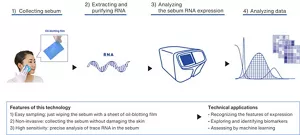Sebum RNA Monitoring Technology—Monitoring with Just a single Sheet of Oil-blotting Film
Biomonitoring
The skin is also known as the “window to the body” and reflects all manner of physical conditions. One type of biomolecule, RNA, serves as an ideal indicator, offering broad and precise information on hidden and subtle changes in the skin.
However, collecting skin RNA is, in general, surgical and highly invasive. However, the collection of skin RNA typically requires surgical procedures, making it a highly invasive method. Therefore, obtaining RNA without damaging the skin would be ideal for monitoring physical conditions.
Discovery of Sebum RNA and Establishing Analytical Technology
Through years of study on sebum, Kao discovered that human-derived messenger RNA (mRNA) is abundant in the sebum*1 .Building on this groundbreaking discovery, Kao developed a novel technique to comprehensively analyze about 10,000 types of human mRNA using just a single sheet of oil-blotting film. The advantage of this technique lies in the ease of RNA collection; anyone can obtain a sample without damaging the skin.
Kao RNA Monitoring
The following video does not include audio, and a text transcription of its visual content is available.
A transcript is available here.
This video briefly explains Kao’s original analytical technology—Sebum RNA monitoring technology.
Facial sebum is collected using an oil-blotting film. Extracting the sebum on the film with a reagent. RNA is extracted from there. Purifying the extracted RNA. Amplifying the purified RNA to a level at which it can be analyzed. Enrichment and purification of the part required for analysis. Processing the portion for sequencing. Making a sample-containing chip for analysis. Analyzing the tip with a sequencer. Displaying results using values that indicate RNA expression. Visualizing the information as values (RNA expression).
This technique opens the door to understanding the skin and physical conditions in detail.
Interpretation of Subtle Physical Changes
Previous studies have reported that sebum RNA can indicate human physiological conditions that change with time—on a daily, monthly, or yearly basis—and be used to accurately monitor the state of diseases such as atopic dermatitis and Parkinson’s disease*2–6 . By taking advantage of this technique, we believe it is possible to: (I) visualize hidden symptoms at an early stage; (II) visualize human physiological changes over time; (III) visualize inner-body conditions; and (IV) suggest solutions optimized for each individual. By using this technique, Kao will continue with activities to realize a society where people stay close to others and live heathy lives with a smile.

Related Information
- Home
- Innovation
- Research & Development
- Fundamental Research
- Biological Science
- Sebum RNA Monitoring Technology—Monitoring with Just a single Sheet of Oil-blotting Film
- Home
- Innovation
- Research & Development
- Fundamental Research
- Biological Science
- Sebum RNA Monitoring Technology—Monitoring with Just a single Sheet of Oil-blotting Film
